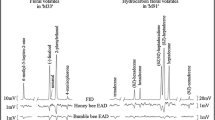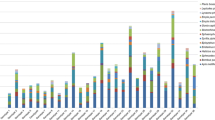Abstract
Steam-distilled floral fragrance oils from nine distinctive cultivars ofTheobroma cacao L. (Sterculiaceae) in Costa Rica were examined with GC-MS to determine whether or not major differences existed among these cultivars for volatile constituents comprising 50% or more of the samples. The cultivars selected for floral oil analyses were chosen to represent diverse cultivars having supposedly different genetic backgrounds and histories of artificial selection for agronomic purposes. Cluster analysis revealed two major groupings of cultivars: those with higher molecular weight dominant compounds, and those having lower molecular weight compounds. Additionally, one cultivar, Rim-100, selected from criollo or ancestral-type cacao in Mexico and resembling criollo in the appearance of flowers and fruits, formed an extreme group having the highest molecular weight profile for major volatile compounds. Based upon these analyses, bioassays using McPhail traps were performed in an abandoned cacao plantation in northeastern Costa Rica during rainy and dry seasons to determine the relative attraction of these oils to flying insects. Bioassays revealed that the Rim-100 cultivar attracted by far the greatest numbers of cacao-associated midges (Diptera: Ceratopogonidae and Cecidomyiidae), as well as stingless bees (Hymenoptera: Apidae: Meliponinae), suggesting that a floral fragrance having high-molecular-weight volatiles is more potent as an attractant to flying insects than floral oils having lower-molecular-weight compounds. It is suggested that Rim-100 more closely resembles an ancestral or wild-type cacao than the other cultivars examined, and therefore it is more effective in attracting opportunistic dipteran floral visitors and pollinators than other cultivars in plantation settings. Several of the major volatile compounds found in the floral oils ofT. cacao and other species ofTheobroma occur in mandibular and other exocrine glands in various bees, including stingless bees and halictids, known visitors ofTheobroma flowers. These compounds are particularly present in noncultivated species ofTheobroma and have much more noticeable fragrances than the seemingly scentless flowers of cultivatedT. cacao selected for agriculture. It is hypothesized that the floral attraction system of ancestral or wild (noncultivated)T. cacao and other species ofTheobroma may have evolved to attract certain bees as their principal pollinators in natural habitats in the Neotropics, with a floral reward hypothesized as being sociochemicals needed by bees for mating, foraging, territorial defense, etc. Because of the many generations of extensive selection by cloning for desired cultivars,T. cacao might have lost much of its original floral attraction system for bees, instead being pollinated opportunistically by dipterans in plantation habitats. This may help to explain why natural pollination in cultivatedT. cacao is generally very poor relative to observed levels of fruit-set in wild or noncultivated species ofTheobroma.
Similar content being viewed by others
References
Aguiar-Falcao, M., andLieras, E. 1983. Aspectos fenologicos, ecologicosce de productividade do cupucao-Theobroma grandflorum (Willd. ex Spreng) Schum.Acta Amazonica 13:725–735.
Allen, J.B. 1982. Collecting wild cocoa in its centre of diversity, pp. 655–662,in Proceedings of the 8th International Cocoa Research Conference, October 1981, Cartegena, Colombia, Stephen Austin, Ltd., London.
Bennett, F.D. 1972. Baited McPhail fruitfly traps to collect euglossine bees.J.N.Y. Entomol. Soc. 80:137–145.
Blum, M.S., Crewe, R.M., Kerr, W.E., Keith, L.H., Garrison, A.W., andWalker, M.M. 1970. Citral in stingless bees: isolation and functions in trail-laying and robbing.J. Insect Physiol. 16:1637–1648.
Brew, A.H. 1986. Studies on natural pollination of cocoa. Cocoa Research Institute of Ghana, Annual Reports, 1982/1983–1984/1985, pp. 100–109.
Bystrak, P.G., andWirth, W.W. 1978. The North American species ofForcipomyia, subgenusEuprojoannisia (Diptera: Ceratopogonidae). Technical Bulletin No. 1591, U.S. Department of Agriculture.
Crewe, R.M., andFletcher, D.J.C. 1976. Volatile secretions of two Old World stingless bees.S. Afr. J. Sci. 72:119–120.
Cuatrecasas, J. 1964. Cacao and its allies, a taxonomic revision of the genusTheobroma.Contrib. U.S. Natl. Mus. 35:379–614.
Dessart, P. 1961. Contribution a l'etude des Ceratopogonidae (Diptera).Bull. Agric. Congo Belge 52:525–540.
Duffield, R.M., Wheeler, J.W., andEickwort, G.C. 1984. Sociochemicals of bees, pp. 387–420,in W.J. Bell and R.T. Cardé (eds.). Chemical Ecology of Insects. Sinauer Associates, Sunderland, Massachusetts.
Enriquez, G.A., andSoria, J.V. 1970. Cacao Cultivars Registers. San Jose, Costa Rica: Instituto de Investigaciones de Ciencias Agricola (I.I.C.A.)
Entwhistle, P.F. 1972. Pests of Cocoa. Longmans, London.
Erickson, B.J., Young, A.M., Strand, M.A., andErickson, E.H., Jr. 1987. Pollination biology ofTheobroma andHerrania (Sterculiaceae). II. Analyses of floral oils.Insect Sci. Appl. 8:301–310.
Gabel, B., Thiery, D., Suchy, V., Marion-Poll, F., Hradsky, P., andFarkas, P. 1992. Floral volatiles ofTanacetum vulagre L. attractive toLobesia botrana Den. et Schiff. females.J. Chem. Ecol. 18:693–702.
Glendenning, D.R. 1962. Natural pollination of cacao.Nature 193:1305.
Hernandez, J. 1965. Insect pollination of cacao (Theobroma cacao L.) in Costa Rica. Unpublished dissertation. University of Wisconsin, Madison, Wisconsin.
Holdridge, L.R. 1966. Life Zone Ecology. Tropical Science Center, San José, Costa Rica.
Ibrahim, A.G., andJussein, A.M. 1987. Role of insects in the pollination of cocoa flowers.Pertanika 10:103–106.
Kaufman, T. 1973. Preliminary observations of cecidomyiid midge and its role as a cocoa pollinator in Ghana.Ghana J. Agric. Sci. 6:1093–1098.
Kaufman, T. 1975a. Biology and behavior of cocoa pollinating Ceratopogonidae in Ghana.Environ. Entomol. 4:347–351.
Kaufman, T. 1975b. An efficient, new cocoa pollinator,Lasioglossum sp. (Hymenoptera: Halictidae) in Ghana, West Africa.Turrialba 25:90–91.
Posnette, A.F. 1944. Pollination of cacao in Trinidad.Trop. Agric. 21:115–118.
SAS Institute. 1990. SAS Language Guide for Personal Computers. SAS Institute, Cary, North Carolina.
Saunders, L.G. 1959. Methods for studyingForcipomyia midges, with special reference to cacaopollinating species (Diptera, Ceratopogonidae).Can. J. Zool. 37:33–51.
Soria, S.de J. 1970. Studies onForcipomyia midges (Diptera, Ceratopogonidae) related to the pollination ofTheobroma cacao L. Unpublished dissertation. University of Wisconsin, Madison, Wisconsin.
Soria, S.de J. 1975. O papel das abelhas sem ferrao (Meliponinae) na pollinizacao o cacaueiro na America tropical.Rev. Theobroma. (Brazil) 5:12–20.
Winder, J.A. 1977. Field observations on Ceratopogonidae and other Diptera: Nematocera associated with cocoa flowers in Brazil.Bull. Entomol. Res. 67:57–63.
Yamida, M. 1991. Genetic studies in cacao (Theobroma cacao L.). Unpublished dissertation. University of Wisconsin, Madison, Wisconsin.
Young, A.M. 1983. Seasonal differences in abundance and distribution of cacao-pollinating midges in relation to flowering and fruit set between shaded and sunny habitats of the La Lola Cocoa Farm in Costa Rica.J. App. Ecol. 20:801–831.
Young, A.M. 1985a. Studies of cecidomyiid midges (Diptera: Cecidomyiidae) as cocoa pollinators (Theobroma cacao L.) in Central America.Proc. Entomol. Soc. Wash. 87:49–79.
Young, A.M. 1985b. Cocoa pollination.Cocoa Growers' Bull. 37:5–23.
Young, A.M. 1985c. Pollen collecting by stingless bees on cacao flowers.Experientia 41:760–762.
Young, A.M. 1989a. Comparative attractiveness of floral fragrance oils of “Rim” and “Catongo” cultivars of cacao (Theobroma cacao L.) to Diptera in a Costa Rican cacao plantation.Turrialba 39:137–142.
Young, A.M. 1989b. Pollination biology ofTheobroma andHerrania (Sterculiaceae). IV. Major volatile constituents of steam-distilled floral oils as field attractants to cacao-associated midges (Diptera: Cecidomyiidae and Ceratopogonidae) in Costa Rica.Turrialba 39:454–458.
Young, A.M., Schaller, M., andStrand, M. 1984. Floral nectaries and trichomes in relation to pollination in some species ofTheobroma andHerrania (Sterculiaceae).Am. J. Bot. 71:466–480.
Young, A.M., Erickson, B.J., andErickson, E.H., Jr. 1987a. Steam-distilled floral oils ofTheobroma species (Sterculiaceae) as attractants to flying insects during dry and wet seasons in a Costa Rican cocoa plantation, pp. 289–296,in Proceedings of the 10th International Cocoa Research Conference, Santo Domingo, The Dominican Republic. Stephen Austin, Ltd., London.
Young, A.M., Erickson, E.H., Jr. andErickson, B.J. 1987b. A trap survey of flying insects in “Finca Experimental La Lola” in Costa Rica.Turrialba 37:337–356.
Young, A.M., Erickson, B.J., andErickson, E.H., Jr. 1988. Pollination biology ofTheobroma andHerrania (Sterculiaceae). III. Steam-distilled floral oils ofTheobroma species as attractants to flying insects in a Costa Rican cocoa plantation.Insect Sci. Appl. 10:93–98.
Author information
Authors and Affiliations
Rights and permissions
About this article
Cite this article
Young, A.M., Severson, D.W. Comparative analysis of steam distilled floral oils of cacao cultivars (Theobroma cacao L., Sterculiaceae) and attraction of flying insects: Implications for aTheobroma pollination syndrome. J Chem Ecol 20, 2687–2703 (1994). https://doi.org/10.1007/BF02036201
Received:
Accepted:
Issue Date:
DOI: https://doi.org/10.1007/BF02036201




